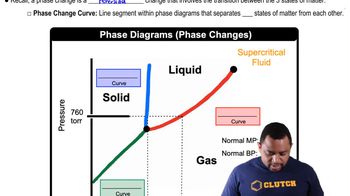Textbook Question
(d) Does the amount of work that a system can do on its surroundings depend on the path of the process?
617
views
 Verified step by step guidance
Verified step by step guidance



(d) Does the amount of work that a system can do on its surroundings depend on the path of the process?
Consider the vaporization of liquid water to steam at a pressure of 1 atm. (a) Is this process endothermic or exothermic?
Consider the vaporization of liquid water to steam at a pressure of 1 atm. (c) In what temperature range is it a nonspontaneous process?
Consider the vaporization of liquid water to steam at a pressure of 1 atm. (d) At what temperature are the two phases in equilibrium?
The normal freezing point of n-octane (C8H18) is -57 °C. (b) In what temperature range is the freezing of n-octane a spontaneous process?